Investigation into the Application of Natural Dyes Obtained from Annatto Seeds and Eucalyptus Leaves in Dyeing Textile Substrates Using Biomordants
Abstract
1. Introduction
2. Materials and Methods
2.1. Materials
2.2. Obtaining Eucalyptus Extract
2.3. Obtaining Annatto Extract
2.4. Mordanting Process of Fabrics
2.5. Dyeing of Samples
2.5.1. Dyeing of Samples with Eucalyptus Leaf Extract
2.5.2. Dyeing of Samples with Annatto Extract
2.6. Evaluation of the Color Intensity of Dyed Fabrics
2.7. Characterization of Biomordanted Fabrics by Scanning Electron Microscopy (SEM)
2.8. Fourier Transform Infrared Spectroscopy-FTIR
2.9. Color Fastness to Washing
3. Results
3.1. Analysis of Colorimetric Results
3.2. Fabric Characterization by Scanning Electron Microscopy Analysis-SEM
3.3. Characterization of Mordanted Fabrics by Fourier-Transform Infrared Spectroscopy (FTIR)
3.4. Color Fastness
4. Final Remarks
Author Contributions
Funding
Institutional Review Board Statement
Informed Consent Statement
Data Availability Statement
Conflicts of Interest
References
- Prant, A.D.; Rahaman, M.T. Extraction of eco-friendly natural dyes and bio-mordants for textile coloration: A critical review. Nano-Struct. Nano-Objects 2024, 39, 101243. [Google Scholar] [CrossRef]
- Yadav, S.; Tiwari, K.S.; Gupta, C.; Tiwari, M.K.; Khan, A.; Sonkar, S.P. A brief review on natural dyes, pigments: Recent advances and future perspectives. Results Chem. 2023, 5, 100733. [Google Scholar] [CrossRef]
- Haji, A.; Naebe, M. Cleaner dyeing of textiles using plasma treatment and natural dyes: A review. J. Clean. Prod. 2020, 265, 121866. [Google Scholar] [CrossRef]
- Phan, K.; Raes, K.; Van Speybroeck, V.; Roosen, M.; De Clerck, K.; De Meester, S. Non-food applications of natural dyes extracted from agro-food residues: A critical review. J. Clean. Prod. 2021, 301, 126920. [Google Scholar] [CrossRef]
- Ibrahim, M.; Bisma; Adeel, S.; Shamim, A.M.; Mehrizi, M.K.; Imran, M.; Tahir, M.A.; Mia, R. Dyeing of silk with isolated bixin based orange yellow natural dye: Kinetic, thermodynamic and colorimetric aspects. Results Eng. 2025, 25, 103794. [Google Scholar] [CrossRef]
- Bueno, A.M.; Hoffmann, T.G.; de Souza, C.K.; de Carvalho, L.F.; Bertoli, S.L.; Barcellos, I.O.; Gonçalves, M.J. Optimal process conditions to recycled polyester dyeing using natural annatto dye. J. Clean. Prod. 2022, 370, 133497. [Google Scholar] [CrossRef]
- Santiago, D.; Cunha, J.; Cabral, I. Chromatic and medicinal properties of six natural textile dyes: A review of eucalyptus, weld, madder, annatto, indigo and woad. Heliyon 2023, 9, e22013. [Google Scholar] [CrossRef] [PubMed]
- Santos, J.; Freitas, B.; Fernandes, R.A.; Escobar-Avello, D.; Gomes, T.; Magalhães, P.; Magalhães, F.D.; Martins, J.M.; Carvalho, L.H. Ultrasonic-assisted water extraction from Eucalyptus globulus leaves and branches, to obtain natural textile dyes with antioxidant properties. Ind. Crops Prod. 2025, 228, 120885. [Google Scholar] [CrossRef]
- Naqvi, S.A.R.; Ul-Wara, K.; Adeel, S.; Mia, R.; Hosseinnezhad, M.; Rather, L.J.; Imran, M. Modern ecofriendly approach for extraction of luteolin natural dye from weld for silk fabric and wool yarn dyeing. Sustain. Chem. Pharm. 2024, 39, 101554. [Google Scholar] [CrossRef]
- Zhang, Y.; Zhou, Q.; Rather, L.J.; Li, Q. Agricultural waste of Eriobotrya japonica L. (Loquat) seeds and flora leaves as source of natural dye and bio-mordant for coloration and bio-functional finishing of wool textile. Ind. Crops Prod. 2021, 169, 113633. [Google Scholar] [CrossRef]
- Periyasamy, A.P. Natural dyeing of cellulose fibers using syzygium cumini fruit extracts and a bio-mordant: A step toward sustainable dyeing. Sustain. Mater. Technol. 2022, 33, e00472. [Google Scholar] [CrossRef]
- Zhang, Y.; Zhou, Q.; Xia, W.; Rather, L.J.; Li, Q. Sonochemical mordanting as a green and effective approach in enhancing cotton bio natural dye affinity through soy surface modification. J. Clean. Prod. 2022, 336, 130465. [Google Scholar] [CrossRef]
- Desnos, R. Botanical Colour at Your Fingertips, 1st ed.; Rebeca Desnos: London, UK, 2016. [Google Scholar]
- Balakrishnan, S. Silk fabric dyeing with Basella alba (Sri Lankan green spinach fruit) natural dyes: Mordant-free dyeing approaches. Ind. Crops Prod. 2024, 222, 119337. [Google Scholar] [CrossRef]
- Mongkholrattanasit, R.; Klaichoi, C.; Rungruangkitkrai, N.; Punrattanasin, N.; Sriharuksa, K.; Nakpathom, M. Dyeing studies with Eucalyptus, quercetin, rutin and tannin: A research on effect of ferrous sulfate mordant. J. Text. 2013, 1, 423842. [Google Scholar] [CrossRef]
- Marquardt, A.L.; de Oliveira, C.R.S.; Volkmann, A.C.; Francisco, I.B.M.; Júnior, A.H.d.S.; de Aguiar, C.R.L. Exploring the dyeing potential of annato dye on linen substrate: Na inquiry into the effects of diferente mordants. Color. Technol. 2024, 141, 405–422. [Google Scholar] [CrossRef]
- Banna, B.U.; Mia, R.; Hasan, M.; Ahmed, B.; Shibly, M.A.H. Ultrasonic-assisted sustainable extraction and dyeing of organic cotton fabric using natural dyes from Dillenia indica leaf. Helyon 2023, 9, e18702. [Google Scholar] [CrossRef] [PubMed]
- Ali, H.; Dilshad, M.R.; Haider, B.; Islam, A.; Akram, M.S.; Jalal, A.; Hussain, S.N. Preparation and characterization of novel Polyamide-6/Chitosan blend dense membranes for desalination of brackish water. Polym. Bull. 2022, 79, 4153–4169. [Google Scholar] [CrossRef]
- Mohamed, I.M.A.; Khalifa, Y.A.; Shaker, A.M.; Nast, L.A.E. Insights into the impact of surfactants on the kinetics of selenium nanoparticles formation via lemon juice-assisted methodology, followed by their antibacterial and antioxidant assessment. J. Mol. Liq. 2024, 398, 124241. [Google Scholar] [CrossRef]


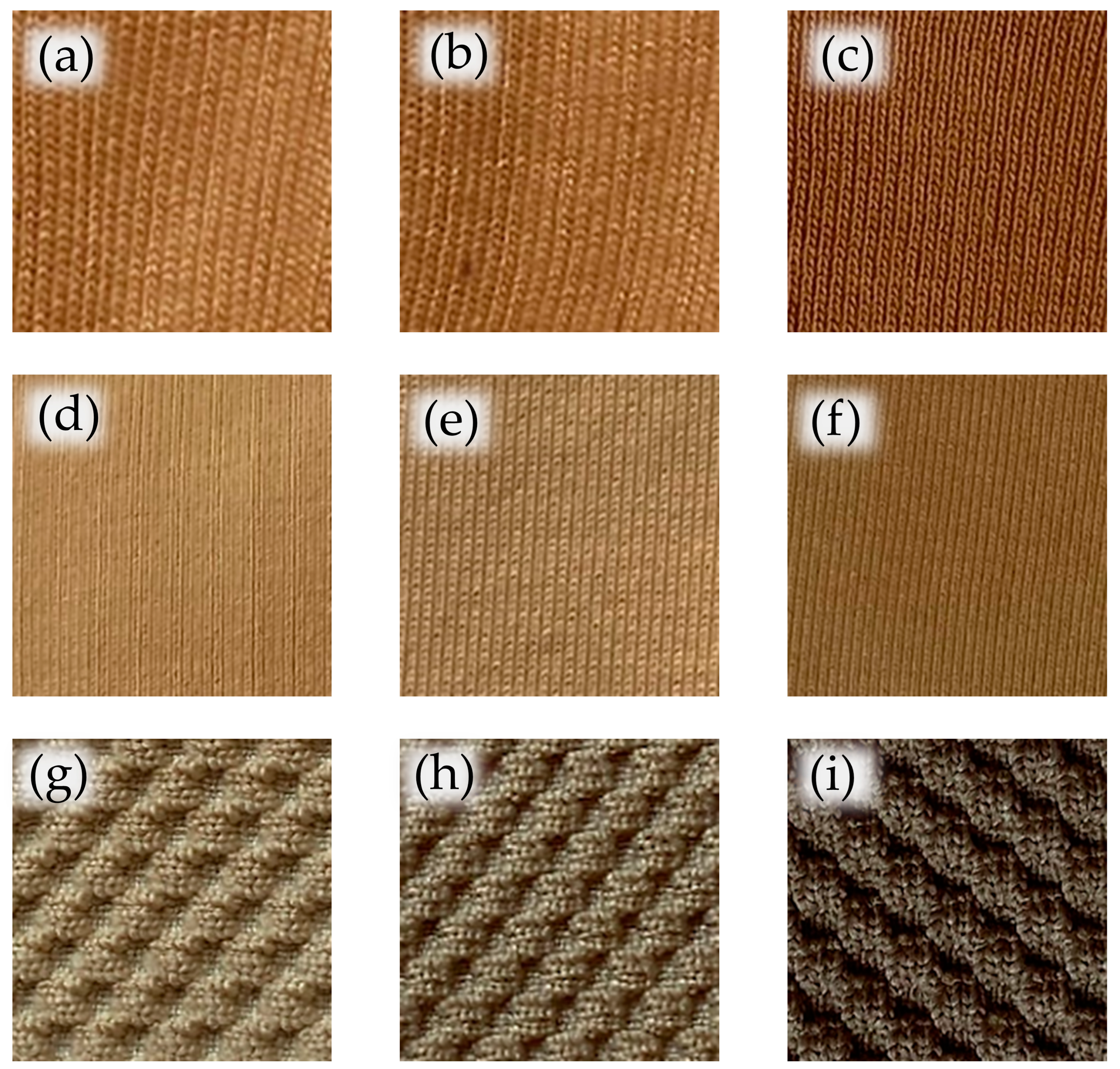
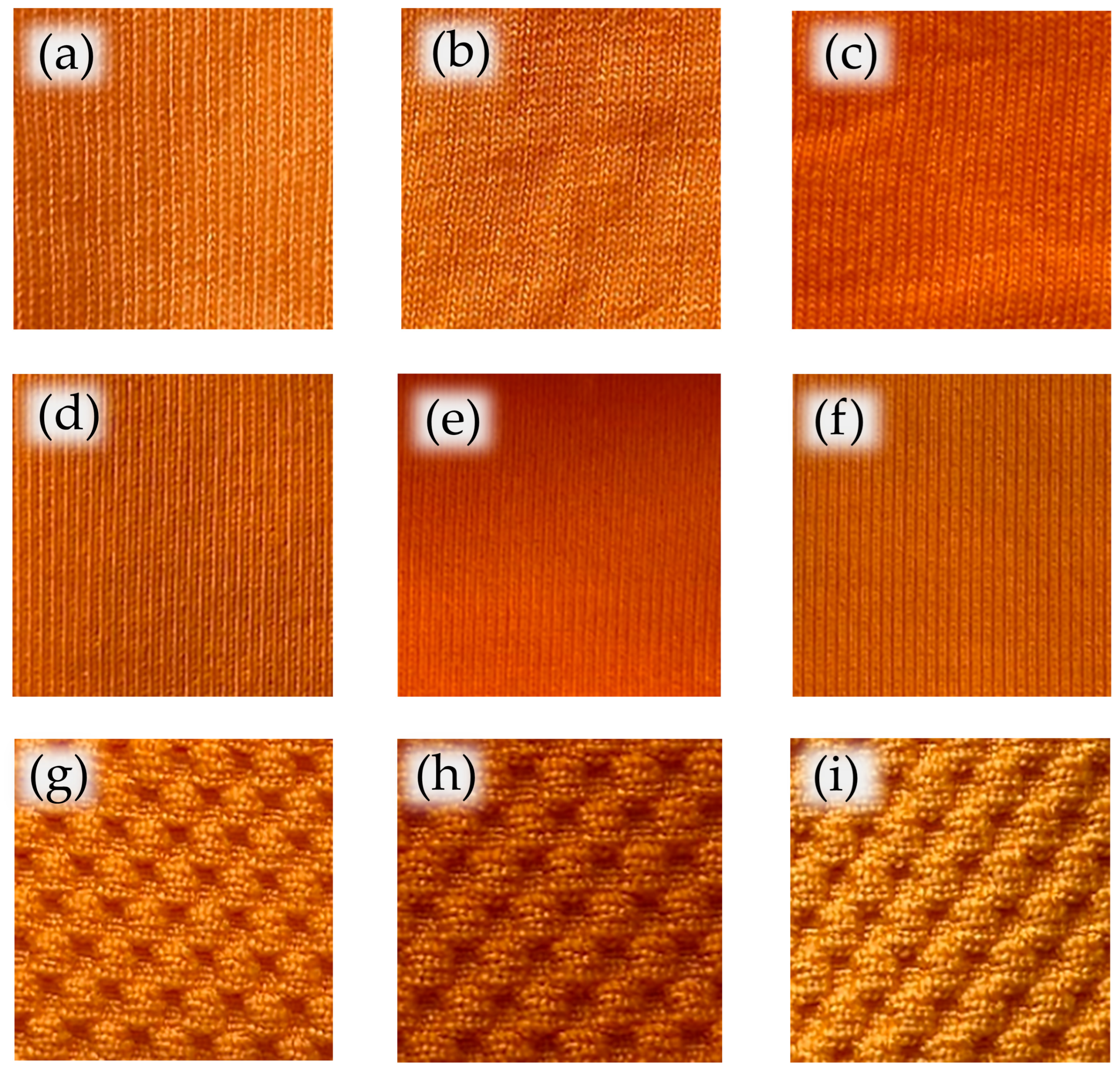

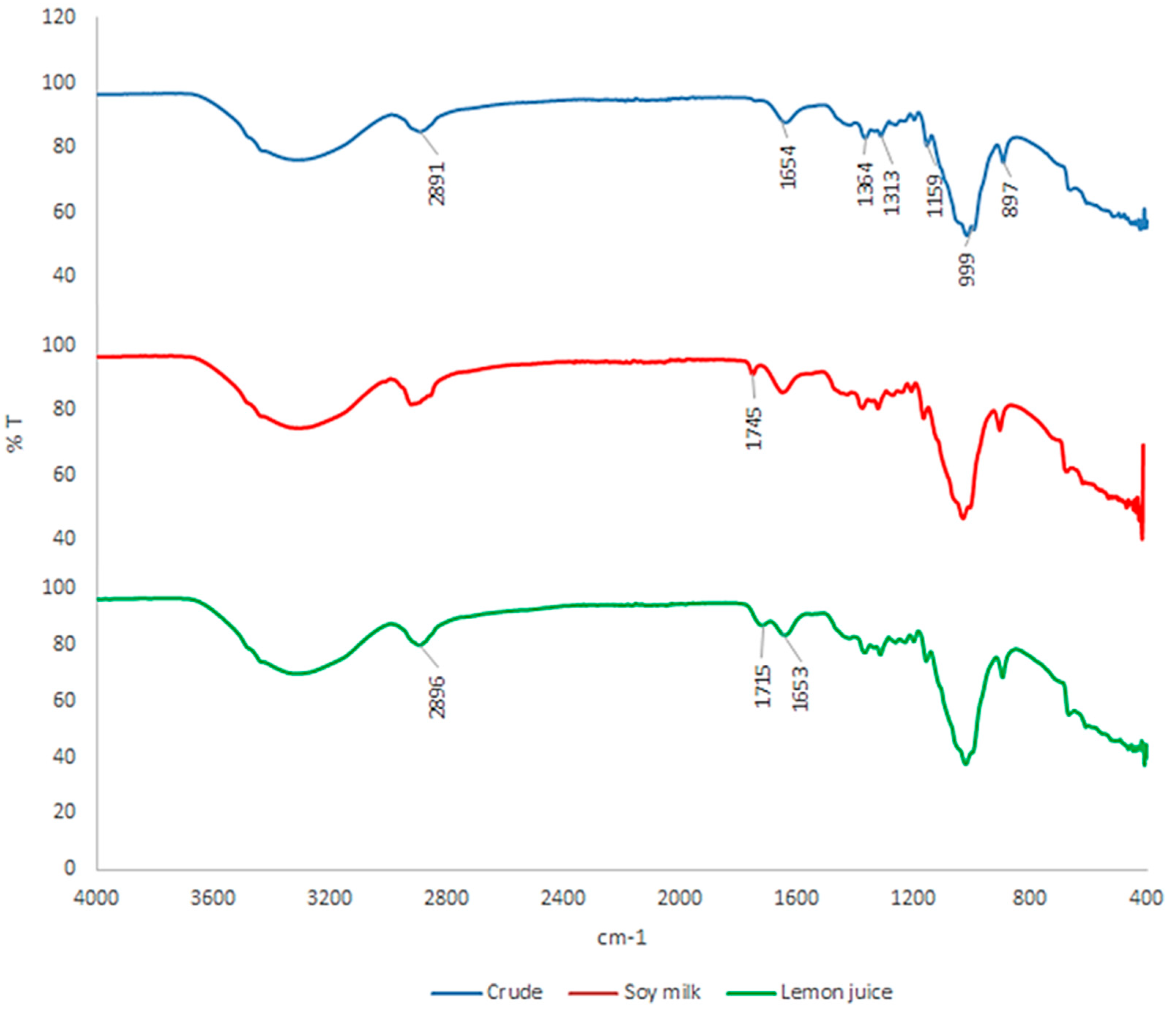
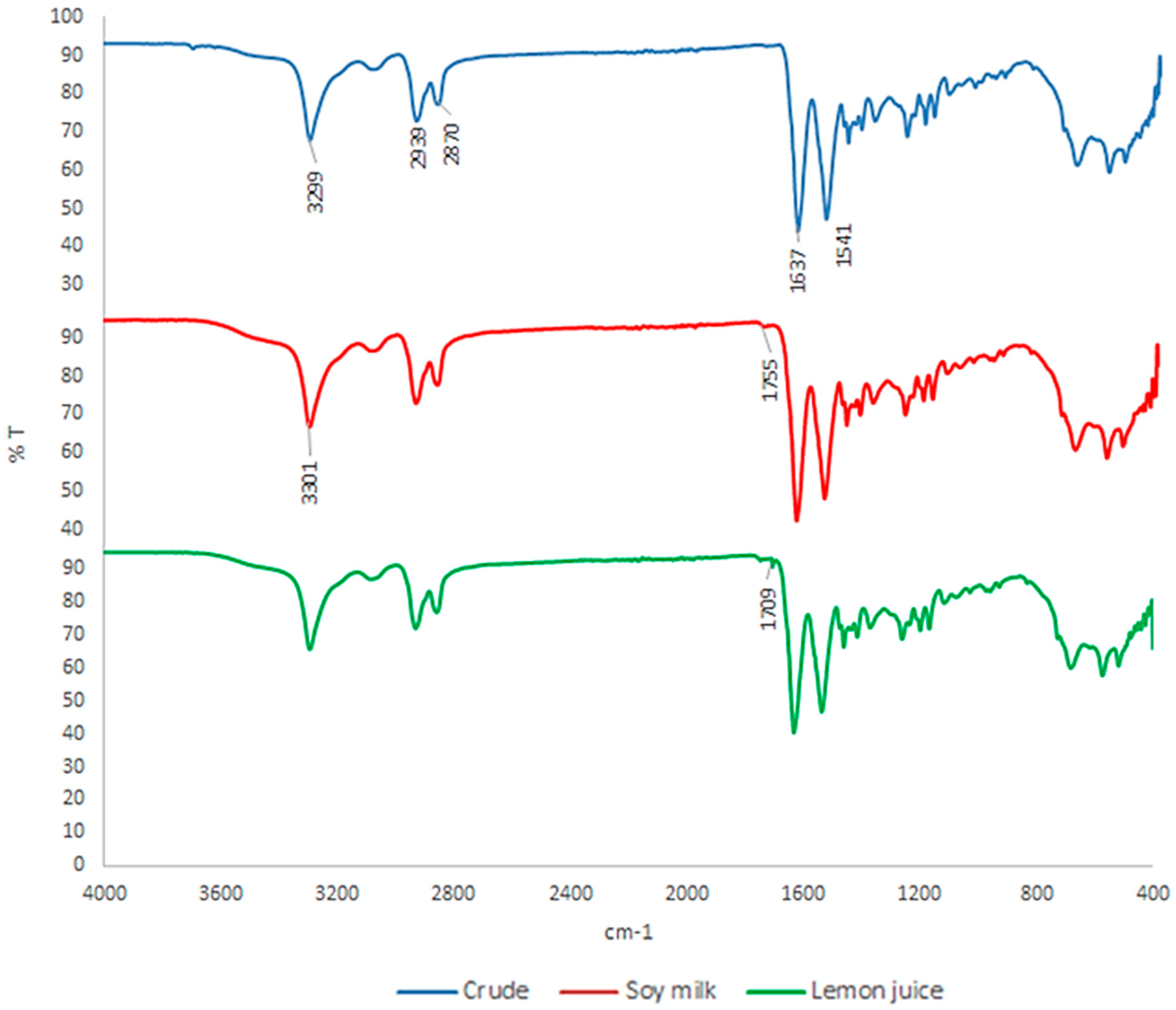
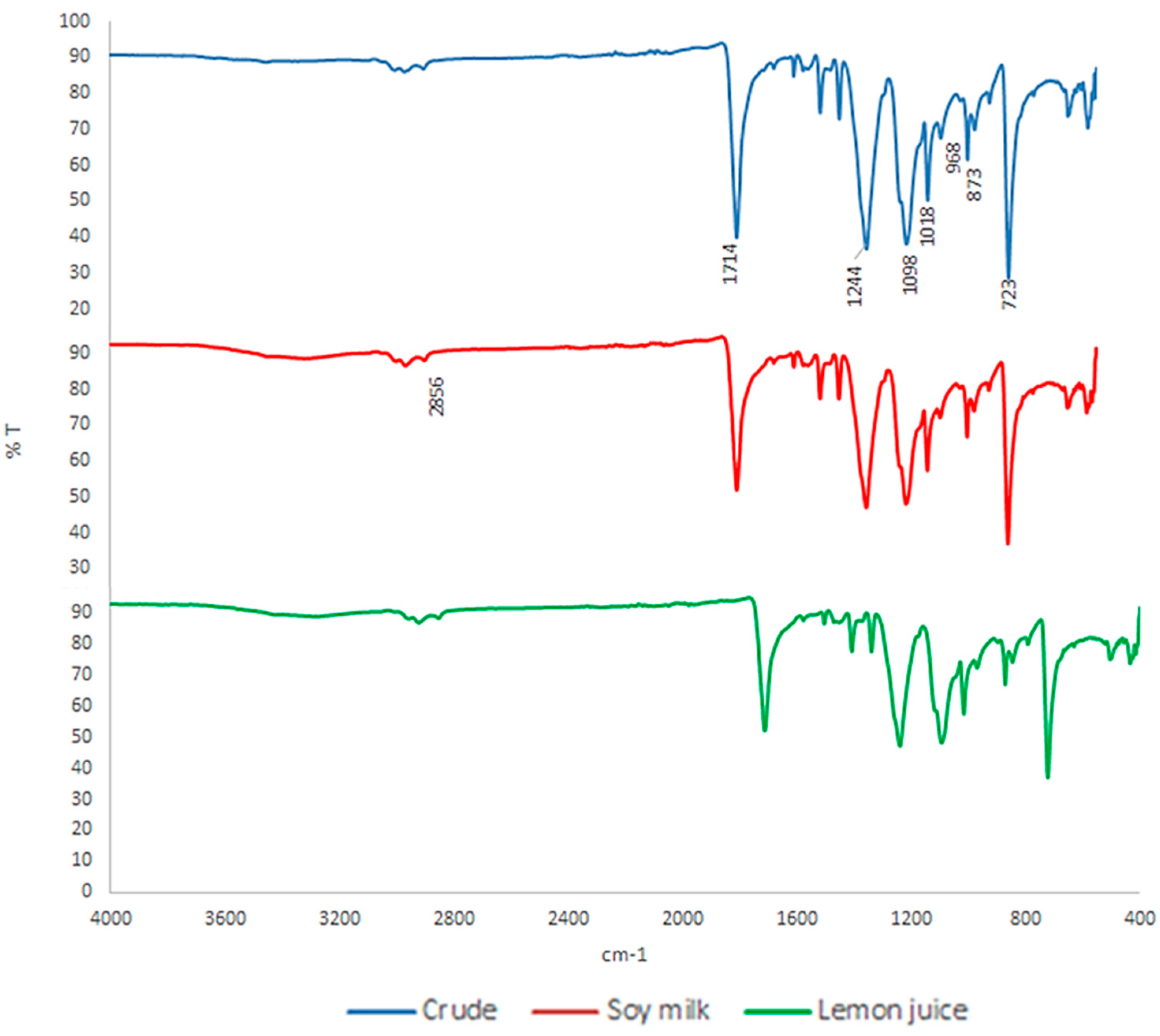
| Cotton | |||||||
|---|---|---|---|---|---|---|---|
| Mordant | ΔL | Δa | Δb | ΔE (CMC) | Color Strength | K/S | Color |
| Crude | 100 | 124.05 |  | ||||
| Lemon juice | 2.73 | 0.69 | 1.03 | 1.43 | 85.65 | 120.29 |  |
| Soy milk | −7.32 | 0.33 | −2.86 | 3.76 | 150.91 | 155.99 |  |
| Polyamide | |||||||
| Mordant | ΔL | Δa | Δb | ΔE (CMC) | Color Strength | K/S | Color |
| Crude | 100 | 104.61 |  | ||||
| Lemon juice | 0.76 | 0.33 | 0.80 | 0.79 | 92.70 | 90.83 |  |
| Soy milk | −6.01 | −0.09 | −2.36 | 2.85 | 139.10 | 108.55 |  |
| Polyester | |||||||
| Mordant | ΔL | Δa | Δb | ΔE (CMC) | Color Strength | K/S | Color |
| Crude | 100 | 22.15 |  | ||||
| Lemon juice | −2.53 | 0.57 | −1.72 | 1.95 | 116.53 | 24.38 |  |
| Soy milk | −16.05 | 1.59 | −3.03 | 7.19 | 295.31 | 56.52 |  |
| Cotton | |||||||
|---|---|---|---|---|---|---|---|
| Mordant | ΔL | Δa | Δb | ΔE (CMC) | Color Strength | K/S | Color |
| Crude | 100 | 32.28 |  | ||||
| Lemon juice | −5.63 | 4.15 | 12.58 | 7.2 | 221.21 | 79.87 |  |
| Soy milk | −10.06 | 8.65 | 17.24 | 9.56 | 366.16 | 124.02 |  |
| Polyamide | |||||||
| Mordant | ΔL | Δa | Δb | ΔE (CMC) | Color Strength | K/S | Color |
| Crude | 100 | 229.26 |  | ||||
| Lemon juice | −0.63 | 2.77 | 1.57 | 1.61 | 114.32 | 251.24 |  |
| Soy milk | 2.87 | −0.69 | −0.54 | 1.30 | 77.80 | 175.27 |  |
| Polyester | |||||||
| Mordant | ΔL | Δa | Δb | ΔE (CMC) | Color Strength | K/S | Color |
| Crude | 100 | 35.06 |  | ||||
| Lemon juice | −6.59 | 10.58 | 13.65 | 7.52 | 257.81 | 91.64 |  |
| Soy milk | −0.68 | 2.96 | 6.52 | 3.14 | 130.76 | 46.66 |  |
| Sample | Change Fastness | Transfer Fastness |
|---|---|---|
| Crude cotton | 4 | 4/5 |
| Cotton treated with lemon juice | 3 | 3 |
| Cotton treated with soy milk | 4 | 4/5 |
| Crude polyamide | 4 | 4 |
| Polyamide treated with lemon juice | 3 | 4 |
| Polyamide treated with soy milk | 4/5 | 4/5 |
| Crude polyester | 4/5 | 4/5 |
| Polyester treated with lemon juice | 3/4 | 4/5 |
| Polyester treated with soy milk | 4/5 | 4/5 |
| Sample | Change Fastness | Transfer Fastness |
|---|---|---|
| Crude cotton | 3/4 | 4/5 |
| Cotton treated with lemon juice | 3 | 2/3 |
| Cotton treated with soy milk | 3 | 4 |
| Crude polyamide | 3/4 | 4/5 |
| Polyamide treated with lemon juice | 4 | 4 |
| Polyamide treated with soy milk | 4/5 | 4 |
| Crude polyester | 4 | 5 |
| Polyester treated with lemon juice | 3/4 | 4 |
| Polyester treated with soy milk | 3/4 | 3/4 |
Disclaimer/Publisher’s Note: The statements, opinions and data contained in all publications are solely those of the individual author(s) and contributor(s) and not of MDPI and/or the editor(s). MDPI and/or the editor(s) disclaim responsibility for any injury to people or property resulting from any ideas, methods, instructions or products referred to in the content. |
© 2025 by the authors. Licensee MDPI, Basel, Switzerland. This article is an open access article distributed under the terms and conditions of the Creative Commons Attribution (CC BY) license (https://creativecommons.org/licenses/by/4.0/).
Share and Cite
Barbosa, L.d.S.; Alves, S.H.; Felipe, B.H.S.; de Oliveira, C.R.S.; de Aguiar, C.R.L. Investigation into the Application of Natural Dyes Obtained from Annatto Seeds and Eucalyptus Leaves in Dyeing Textile Substrates Using Biomordants. Colorants 2025, 4, 26. https://doi.org/10.3390/colorants4030026
Barbosa LdS, Alves SH, Felipe BHS, de Oliveira CRS, de Aguiar CRL. Investigation into the Application of Natural Dyes Obtained from Annatto Seeds and Eucalyptus Leaves in Dyeing Textile Substrates Using Biomordants. Colorants. 2025; 4(3):26. https://doi.org/10.3390/colorants4030026
Chicago/Turabian StyleBarbosa, Louise de Sousa, Sophia Helena Alves, Brenno Henrique Silva Felipe, Carlos Rafael Silva de Oliveira, and Catia Rosana Lange de Aguiar. 2025. "Investigation into the Application of Natural Dyes Obtained from Annatto Seeds and Eucalyptus Leaves in Dyeing Textile Substrates Using Biomordants" Colorants 4, no. 3: 26. https://doi.org/10.3390/colorants4030026
APA StyleBarbosa, L. d. S., Alves, S. H., Felipe, B. H. S., de Oliveira, C. R. S., & de Aguiar, C. R. L. (2025). Investigation into the Application of Natural Dyes Obtained from Annatto Seeds and Eucalyptus Leaves in Dyeing Textile Substrates Using Biomordants. Colorants, 4(3), 26. https://doi.org/10.3390/colorants4030026








